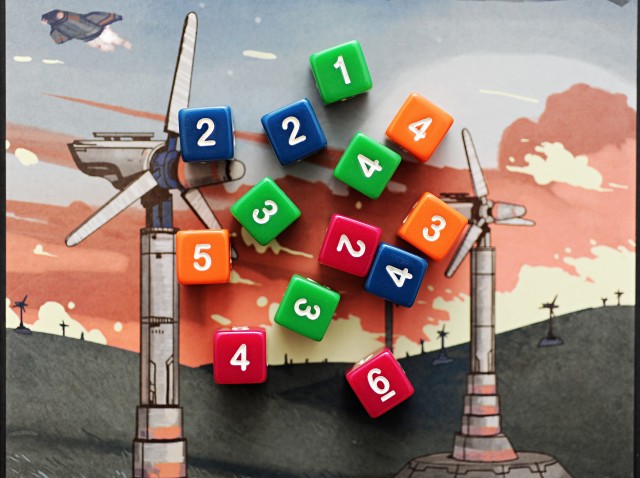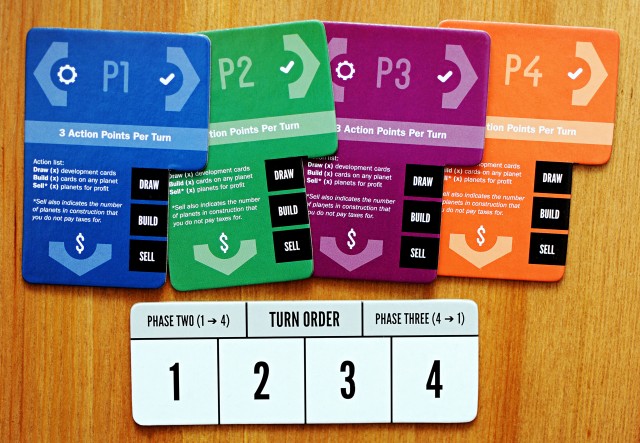Based out of Toronto, I’m lucky to have access to some of the great board gaming minds of the day. Many members of The Game Artisans of Canada are in or within a few hours drive of the city and events like Snakes & Lattes Designer Night keep the community thriving, not to mention Eric Lang’s regular play testing meet up.
The last place I thought I’d meet a designer is at my day job. I work at Early Bird Coffee and Brew Bar where I have very modest success making awesome coffee. When I started there and my board game addiction became a topic of discussion, everyone told me that I would get along with Paul due to our shared love of gaming.
Paul Tseng is more than a board game fan, he’s also a designer. His first published work will debut at GenCon this year. Outer Earth, published by Mailbox Games, his own company, will be available to play test or purchase at booth #2820 in Indianapolis.
“I have been playing video games ever since I can remember, however I entered the board game scene only a few years ago. As for designing board games, I can pinpoint it to April 2013,” said Tseng.
For a first time design, OE is extremely solid. It’s got a polish that many long time designers would envy. Tseng poured a lot of himself into the process. “It initially was developed over 3 months for Cards Against Humanity’s Tabletop Deathmatch. After that I spent a year and a half working on refinements and improvements that finally lead to its successful Kickstarter campaign.”
OE is a mixture of hand management, set collection and push your luck. In the not too distant future, terraforming planets is big business. Players will compete to buy and develop planets and then sell them off to improve actions and gain points. Depending on the path you take to develop your planets, you might be able to gain Super Structures worth big points.
OE is mainly a card game. Development cards, Planet cards and Super Structure cards will make up three separate decks. At the start of the game you’ll create the decks depending on the number of players. Each player has an Action board that will form the start of their tableau. Players gets four dice in their colour. Three of them will be put beside their actions with the ‘1’ face up. This indicates the current strength they can execute the actions (draw, build and sell).
Developments determine the composition of the planets you build them on. They come in three different flavours – blue, yellow and red – and each colour refers to the start path of the card. Each development has paths entering and and leaving that particular card. A blue card will always have a blue start path, but might exit on red or both yellow and blue or even all three. The exit path informs you of the colour of the next card. You’ll only ever be able to extend one path, so if the previous card exited on all three colours, you can extend it with any coloured card. However, if the last card only exited on blue, then you need to use a blue development to extend that path.
There are four phases to each round. It starts with a bid to determine turn order. In phase two, Buying Planets, the turn order goes from 1-4, in phase three, Executing Actions, turns go from 4-1. Going earlier to buy planets might allow you to grab one that works well for your hand of developments, but executing action sooner might give you the chance to complete development on a planet first and possibly earn a Super Structure card before your opponents.
There is always one extra planet for sale then the number of players. The cost for any planet is a development card, but you’re not obligated to grab one. It’s often a good decision to hold off if you are already working on a planet or two. Planets each have a minimum number of developments (those coloured cards mentioned above) required before you’re able to sell them. Once that number is met you can sell the planet. It goes to your planet portfolio, beside your action board and will give you a temporary boost to some or all of your actions. For example it might add +2 to your capacity to build. Now when you use one of your actions to build developments on planets you can do it with greater efficiency. Other planets may give you the choice of permanently upgrading one of your actions. Once you sell your next planet it goes on top of your planet portfolio covering the previous one and altering the temporary action bonus you receive.
 Developments used on planets go to your profit pile when the planet is sold. They are worth a point each at the end of the game. That is, of course, unless they can be used to complete a Super Structure. The super structures also have development requirements, for example one may require two yellows and a red. If you used a combination that matches one of the available super structures when developing a planet you can discard those developments and get the structure, putting it in your profit pile. They will be worth their face value at the end of the game. Some Super Structures will also allow you to permanently improve your actions as well.
Developments used on planets go to your profit pile when the planet is sold. They are worth a point each at the end of the game. That is, of course, unless they can be used to complete a Super Structure. The super structures also have development requirements, for example one may require two yellows and a red. If you used a combination that matches one of the available super structures when developing a planet you can discard those developments and get the structure, putting it in your profit pile. They will be worth their face value at the end of the game. Some Super Structures will also allow you to permanently improve your actions as well.
The fourth phase is mainly to clean up. Any planets they didn’t get bought get a development card placed under them, making them more appealing next round. Players with too many planets on the go, pay a penalty and then you check to see if game end is triggered.
The game end is triggered when the planet pile or any two of the Super Structure piles runs out. The last round is played out and then you total up the points. It’s pretty simple to get a handle on the rules and plays in about an hour.
One of the most memorable aspects of OE is the incredible art by Daniel Orellana. The Super Structures don’t have names or titles, but they hint of beautiful futuristic alien worlds. You could write a book of short sci-fi stories based on those cards alone.
Going the self publishing route was an interesting decision for Tseng. It can be a great deal of work to get a game produced by a large publisher and you often lose control of many of the creative elements. “Outer Earth was initially a game I wanted to hand over to a publisher. I tried pitching it to a few and as a medium weight game, it just was not one that publishers wanted to take on with the risks of a new designer.” It has definitely been an educational experience for him, “There are tons of challenges in going the self-publishing route. Designing the game is the ‘easy’ part. When you decide to self-publish, everything is on your shoulders. Graphic design, art, marketing, fulfillment, logistics, manufacturing and of course game design. If you are able to either do all of the above or get together a team that can cover all your bases then you are golden.”
Tseng isn’t stopping with OE and GenCon. Mailbox Games has more projects on the go. “Currently we are working on a game called Tofu Sliders (name still not solidified!). It is a tile pushing game where you are a chef that uses your helpers to collect ingredients from the board to then fulfill orders from the restaurant.”
The Toronto gaming community has been key in helping Tseng develop his games. “The monthly designer nights at Snakes & Lattes have been a great asset to meet with fellow board game designers and playtesters,” said Tseng. “And Toronto’s yearly Board Game Jam where you make a game in 48 hours is a great way to meet likeminded people and put your design skills to the test.”
It’s great to see young designers taking control of their destiny and getting their games out there by any means necessary. If Outer Earth is not on your must play games for GenCon this year, you should definitely add it. I can’t wait to see what Tseng and Mailbox Games come up with next.
Well done for a first time publisher, best of luck.